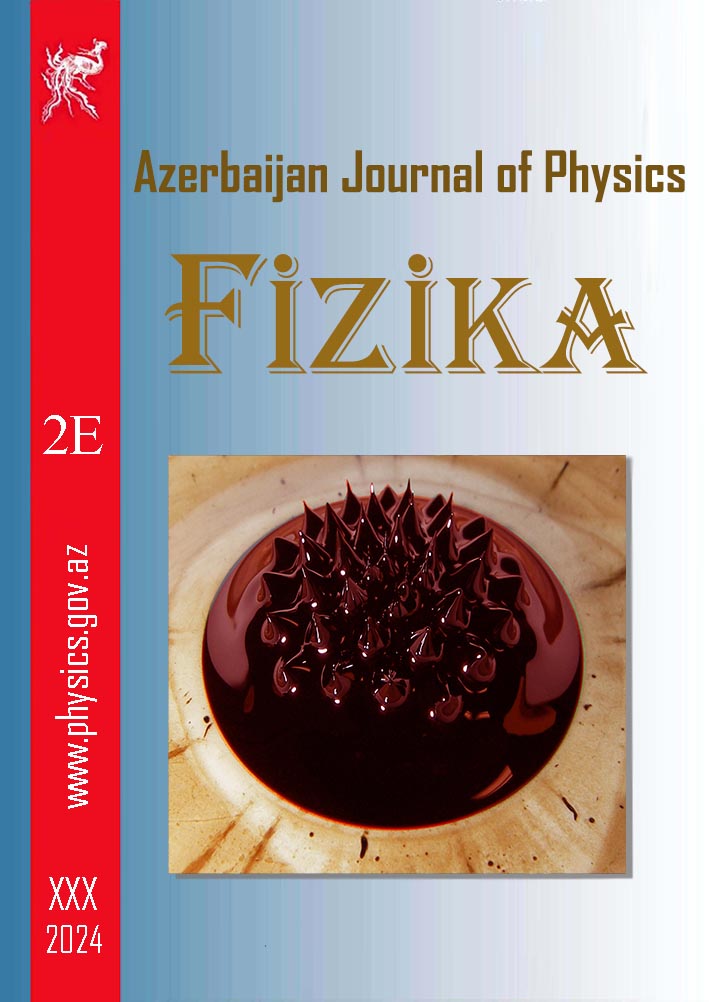ABSTRACT
The interrelation between structure, dynamics and biomolecule functiones is the one of fundamentl interest of biophysics. The protein dynamics significantly changes in time
and space. The hydratation influence on fibroin protein dynamics obtained from cocoon silk is investigated in present article. The hydratation is carried out by the change
of percentage of glycerine-water mixture. The temperature-dependent recombination of free radicals in proteins caused by ultraviolet radiation (UV) is of the special
interest. The total recombination takes place in range 120-340K in the dependence on hydratation level. The three points of the transition on burning curve of free radicals
generated by ultraviolet radiation at 77K, are observed in hydrated fibroin protein. It is seen that transition temperatures are ~135 К, 205 К and 279 К. The increase of
free radical quantity on 2-6% takes place at temperature ~135K. The first transition in recombination of free radicals caused by ultraviolet beams takes place when mixture
of glycerine and water is 40% and 50%. The second transition is observed in both wet and dry samples of fibroin at temperature ~205K. The third transition takes place at
363K at higher temperatures in fibroin dry samples and at 279K at relatively low temperatures in wet samples. At 205K the transitions with water molecules are weak ones and
at 279K the transitions are strong ones. The radical nature taking part in transitions is established.
Keywords: EPR, fibroin, UV rays, free radical processes, recombination of free radicals.
PACS: 87.64.-t
DOI:-
Received: 25.09.2020
AUTHORS & AFFILIATIONS
Azerbaijan National Academy of Sciences, Institute of Biophysics, 117 Z. Khalilov street, Baku, AZ-1141
E-mail:
|
[1] L. Meinhold, J.C. Smith, A. Kitao and A.H. Zewail. “Picosecond _uctuating protein energy landscape mapped by pressure temperature molecular dynamics simulation,” Proceedings of the National Academy of Sciences, 2007, vol. 104, № 44, pp. 17261-17265.
[2] H. Frauenfelder. Physical Biology, 2017, vol. 14, № 1, p. 010402.
[3] H. Frauenfelder, R. D. Young, and P. W. Fenimore. J. Phys. Chem. B, 2013, vol. 117, № 42, pp. 13301-13307.
[4] O. I. Aruoma. Journal of the American Oil Chemists’ Society, 1998, vol. 75, № 2, pp. 199-212.
[5] Q. Dong, H. Su, and D. Zhang. Journal of Physical Chemistry B, 2005, vol. 109, № 37, pp. 17429-17434.
[6] B.D.Lawrence, J.K.Marchant, M.A.Pindrus, F.G. Omenetto and D. L. Kaplan. Biomaterials, 2009, vol. 30, № 7, pp. 1299-1308, 2009.
[7] G. Yin, Z. Huang, M. Deng, J. Zeng, and J. Gu. 2011, Journal of Coll.Interf. Sci., vol.363, № 1, pp. 393-402.
[8] X.X. Feng, L.L. Zhang, J.Y. Chen, Y.H. Guo, H.P. Zhang, and C.I. Jia. International J. Biological Macromolecules, 2007, vol. 40, № 2, pp. 105–111.
[9] Y. Tamada. Biomaterials, 2004, vol. 25, № 3, pp. 377-383.
[10] X. Wang, J.A. Kluge, G.G. Leisk and D.L.Kaplan. Biomaterials, 2008, vol. 29, № 8, pp. 1054-1064.
[11] E. Wenk, A.J. Wandrey, H.P. Merkle, and L. Meinel. J. Controlled Release, 2008, vol. 132, № 1, pp. 26-34.
[12] A. Matsumoto, J. Chen, A. L. Collette et al.. Journal of Physical Chemistry B, vol. 110, № 43, pp. 21630–21638, 2006.
[13] C.Z. Zhou. Nucleic Acids Research,2000, vol. 28, № 12, pp. 2413-2419.
[14] О.И. Агапова, И.И. Агапов. Биодеградируемые изделия на основе фиброина шелка для тканевой инженерии и регенеративной медицины.
[15] Yang Cao and Bochu Wang. International Journal of Molecular Sciences, 2009, 10, 1514-1524.
[16] T. Lef`evre, M.E. Rousseau and M. Pґezolet. Biophysical Journal, 2007, vol. 92, № 8, pp. 2885–2895.
[17] J. Shao, C.M. Carr, C.P. Rowlands and J. Walton. Journal of the Textile Institute,1999, vol. 90, № 4, pp. 459–468.
[18] S.V. Mamedov, B. Akta, M. CantЁurk et al.. Biomaterials, 2002, vol. 23, № 16, pp.3405-3412.
[19] R. Liu, L. Xie and K. Sheng. Nuclear Science and Techniques, 2007, vol. 18, № 5, pp. 268-271.
[20] A. Sionkowska and A. Planecka. Polymer Degradation and Stability, 2011, vol. 96, № 4, pp. 523-528.
[21] K. Setoyama. Journal of Sericultural Science of Japan, 1982 vol. 51, № 4, pp. 271-278.
[22] K.M. Lvov and Y.A. Kim. 1975, Biopolymers, vol. 14, № 1, pp. 83-91.
[23] Danielle N Rockwood, Rucsanda C Preda, Tuna Yücel, Xiaoqin Wang, Michael L Lovett & David L Kaplan. Nature protocols, 2011, vol. 6, № 10.
[24] M.T. Neves-Petersen, S.Klitgaard, T.Pascher et al.. Biophysical Journal, 2009, vol. 97, № 1, pp. 211-226.
[25] B.P. Partlow, M. Bagheri, J.L. Harden, and D.L. Kaplan, Biomacromolecules, 2016, vol. 17, № 11, pp. 3570-3579.
[26] P.S. Sherin, O.A. Snytnikova, and Y.P. Tsentalovich. Chemical Physics Letters, 2004, vol. 391, № 1-3, pp. 44-49.
[27] J. Liu, J. Shao, and J. Zheng. Journal of Applied Polymer Science, 2004, vol. 91, № 3, pp. 2028-2034.
[28] W. Li, X. Qiao, K. Sun and X. Chen. Journal of Applied Polymer Science, 2009, vol. 113, № 2, pp. 1063-1069.
|
